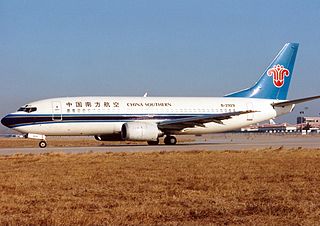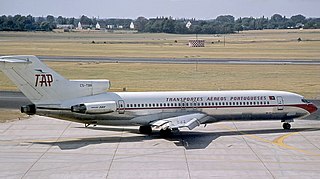
On March 27, 1977, two Boeing 747 passenger jets, operating KLM Flight 4805 and Pan Am Flight 1736, collided on the runway at Los Rodeos Airport on the Spanish island of Tenerife. Resulting in 583 fatalities, this accident is the deadliest in aviation history.

In aviation, an instrument approach or instrument approach procedure (IAP) is a series of predetermined maneuvers for the orderly transfer of an aircraft under instrument flight conditions from the beginning of the initial approach to a landing or to a point from which a landing may be made visually. These approaches are approved in the European Union by EASA and the respective country authorities and in the United States by the FAA or the United States Department of Defense for the military. The ICAO defines an instrument approach as a series of predetermined maneuvers by reference to flight instruments with specific protection from obstacles from the initial approach fix, or where applicable, from the beginning of a defined arrival route to a point from which a landing can be completed and thereafter, if landing is not completed, to a position at which holding or enroute obstacle clearance criteria apply.

American Airlines Flight 383 was a nonstop flight from New York City to Cincinnati on November 8, 1965. The aircraft was a Boeing 727, with 57 passengers, and 5 crew on board. The aircraft crashed on final approach to the Cincinnati/Northern Kentucky International Airport located in Hebron, Kentucky, United States. Only three passengers and one flight attendant survived the crash.

China Southern Airlines Flight 3456 (CZ3456/CSN3456) was a scheduled domestic passenger flight from Chongqing Jiangbei International Airport to Shenzhen Huangtian Airport. On May 8, 1997, the Boeing 737 performing this route crashed during the second attempt to land in a thunderstorm. The flight number 3456 is still used by China Southern and for the Chongqing-Shenzhen route but now with the Airbus A320 family or Boeing 737 Next Generation aircraft.

TAP Flight 425 was a regular flight from Brussels, Belgium, to Santa Catarina Airport, Portugal, with an intermediate scheduled stop in Lisbon. On November 19, 1977, the Boeing 727 operating the service overran the airport's runway before crashing onto the nearby beach and exploding, killing 131 of the 164 people on board. It remains TAP's only fatal accident in its history.

Aviastar-TU Airlines Flight 1906 was a Tupolev Tu-204 which crash-landed while attempting to land at Domodedovo airport, Moscow, Russia, in heavy fog on 22 March 2010. The aircraft of Aviastar-TU Airlines was on a ferry flight from Hurghada International Airport, Egypt to Domodedovo. There were no passengers on board and all eight crew survived the accident. Four crew members were seriously injured and taken to a hospital, while others suffered minor injuries. The accident was the first hull loss of a Tu-204 and the first hull loss for Aviastar-SP.

The 1950 Heathrow BEA Vickers Viking crash occurred on 31 October 1950 when a Vickers Viking operated by British European Airways (BEA) crashed at London Airport in heavy fog. The aircraft was on a scheduled flight between Paris and London's Northolt airport and 28 of the 30 passengers and crew on board were killed.

Allegheny Airlines Flight 485 was a regularly scheduled domestic passenger flight between Washington, D.C. and Newport News, Virginia, United States, with three stop-overs, two in Connecticut and a third in Pennsylvania. On June 7, 1971, the Allegheny Airlines Convair CV-580 operating the flight crashed on approach to Tweed New Haven Regional Airport, New Haven County, Connecticut.

Swiss International Air Lines Flight 850 was an international scheduled passenger flight from Basle, Switzerland, to Hamburg, Germany. On 10 July 2002, the flight was unable to land at Fuhlsbüttel Airport due to weather. Attempts were made to divert to other airports at Berlin and Eberswalde before the crew decided to land at Werneuchen. On landing, the aircraft struck an earth bank which ripped off all three undercarriage legs, and came to rest on its belly with an engine on fire. One of the sixteen passengers suffered minor injuries. The aircraft was written off.

On 4 April 2011, a Bombardier CRJ-100 passenger jet of Georgian Airways operating a domestic flight from Kisangani to Kinshasa, Democratic Republic of Congo on behalf of United Nations, crashed while attempting to land in a thunderstorm at Kinshasa Airport. Of the 33 people on board, only one, a passenger, survived.

Aeroflot Flight 721 was a scheduled domestic passenger flight between Moscow and Yuzhno-Sakhalinsk in the Russian SFSR. On Wednesday, 2 September 1964, the aircraft flying this route, an Ilyushin Il-18V, crashed into the side of a hill on approach to Yuzhno-Sakhalinsk, killing 87 of the 93 people on board. At the time of the accident it was the deadliest Il-18 crash and the deadliest aviation accident on Russian soil.

Aeroflot Flight 528 was a regular commercial flight from Odessa to Berdyansk that crashed while attempting to land in poor weather conditions.

Aeroflot Flight 99 was a Tupolev Tu-124 operating a scheduled domestic passenger flight from Leningrad to Murmansk, both in the Soviet Union, which crashed while attempting to land on 11 November 1965. Of the 64 passengers and crew on board, 32 were killed in the accident, and many of the survivors sustained injuries.

Aeroflot Flight 191 was a Soviet domestic passenger flight from Vnukovo International Airport to Ashgabat International Airport, with a stopover in Turkmenbashi International Airport. On 5 March 1963, the Ilyushin Il-18 crashed while landing at Ashgabat International Airport as a result of a dust storm. 12 of the 54 people on board were killed.

Aeroflot Flight 1912 was a scheduled domestic Aeroflot passenger flight on the Odessa-Kyiv-Chelyabinsk-Novosibirsk-Irkutsk-Karbarovsk-Vladivostok route that crashed on 25 July 1971, making a hard landing at Irkutsk Airport. It touched down 150 m (490 ft) short of the runway, breaking the left wing and catching fire. Of the 126 people on board the aircraft, 29 survived.

Pulkovo Aviation Enterprise Flight 9045 was a cargo flight that crashed on approach to Nalchik while carrying 12,515 kg of coins from the Saint Petersburg Mint.

Aeroflot Flight 2808 was a scheduled domestic passenger flight from Mineralnye Vody to Ivanovo, both in Russia, with a stopover in Donetsk, Ukraine on 27 August 1992. While attempting to land at Ivanovo airport, the Tupolev Tu-134 crashed into a group of buildings in the village of Lebyazhy Lug. Investigators determined the cause of the accident was errors made by the crew and the air traffic controller. There were no fatalities on the ground, but all 84 people on board the flight died in the crash.

Aeroflot Flight 20 was a scheduled domestic passenger flight from Moscow to Alma-Ata with a stopover in Omsk that crashed in low visibility conditions on 4 January 1965, killing 64 of the 103 people on board.

Aeroflot Flight U-45 was a passenger flight operated by an Ilyushin Il-18 that crashed during the approach to Samarkand on Friday, 6 February 1970, resulting in the death of 92 of the 106 people on board. An investigation revealed the aircraft went below the minimum obstacle clearance altitude (MOCA) during approach to Samarkand International Airport.

Aeroméxico Connect Flight 2431 (SLI2431/5D2431) was a Mexican domestic scheduled passenger flight bound for Mexico City that crashed on takeoff from Durango International Airport on July 31, 2018. Shortly after becoming airborne, the plane encountered sudden wind shear caused by a microburst. The plane rapidly lost speed and altitude and impacted the runway, detaching the engines and skidding to a halt about 1,000 feet (300 m) beyond the runway. The plane caught fire and was destroyed. All 103 people on board survived, but 39 passengers and crew members were injured.



















